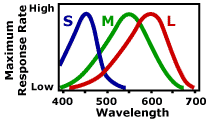Trichromacy

| Light #1: |
Light #2: |
||||||||||||||||||||||||||||||||||||||||||||||||||||||||||||||||||||||||||
|
|
||||||||||||||||||||||||||||||||||||||||||||||||||||||||||||||||||||||||||
|
|
||||||||||||||||||||||||||||||||||||||||||||||||||||||||||||||||||||||||||
|
|
||||||||||||||||||||||||||||||||||||||||||||||||||||||||||||||||||||||||||
| Wavelength: 500 | Wavelength: 600 | ||||||||||||||||||||||||||||||||||||||||||||||||||||||||||||||||||||||||||
| Amplitude: 90 | Amplitude: 90 | ||||||||||||||||||||||||||||||||||||||||||||||||||||||||||||||||||||||||||
|
|
|
||||||||||||||||||||||||||||||||||||||||||||||||||||||||||||||||||||||||||
Introduction
You should complete “The Principle of Univariance” activity before completing this one.
This activity demonstrates how the visual system uses three types of cones to distinguish between different wavelengths and intensities of light.
Instructions
Change the color of either Light #1 or Light #2 (by clicking on one of the colored squares at the lower left), and observe the effects on the firing rates of the three types of receptors.
Trichromacy, Part I
When this activity first loads, Lights #1 and #2 are set at 500 nm (sky blue) and 600 nm (yellow) wavelengths, respectively, with both lights at 90% amplitude. These lights were cited in the “Principle of Univariance” activity as one pair of lights that were indistinguishable on the basis of the single cone receptor type included in that activity. However, the reason humans can distinguish between these two lights is that we have not one, but three types of cones (hence the term trichromacy).
The maximum response rate curves for the three human cone types are shown in the graph in the upper left. The cone type featured in the Univariance activity is now revealed to be the M-cone (“M” for medium wavelength). The other two types of cones are known as S- (short wavelength) and L- (long wavelength) cones. As shown in the graph, the peak wavelengths (that is, the wavelengths that cause the highest maximum response rates) are about 450 nm (blue), 550 nm (green), and 600 nm (yellow) for the S-, M-, and L-cones, respectively.
Trichromacy, Part II
The response rates for all three types of cones are shown at the middle left. As you can see, the M-cone response for these two lights is identical (as demonstrated in the Univariance activity). However, the responses generated by the S- and L-cones differ for the two lights: the S-cone responds at a faster rate to Light #1 than to Light #2, while the L-cone fires faster to Light #2 than to Light #1. Thus the pattern of response rates over the three cone types uniquely describes each of the two colors.
In fact, every color in the rainbow elicits a unique pattern of responses from the S-, M-, and L-cones. Experiment for yourself by choosing different colors for Light #1 and Light #2, and try to find a pair of lights that produce the same pattern of response rates across all three cones. When you are satisfied that it cannot be done*, click on the Color Blindness link to read about what happens when a person is missing one type of cone.
*Actually, all the 10%-amplitude lights produce the same response in our demonstration—the baseline firing rates for the three cone types. In reality, lights this dim would produce a weak, but above baseline, response in some combination of cone types. Note, however, that it is more difficult to discriminate colors for dim lights than for brighter lights.
Color Vision Deficits, Part I
Set Light #1 to 600 nm (yellow) at 50%. Then set Light #2 to 550 nm (green) at 70%. Like any other pair of lights, each elicits distinct patterns of responses from the three types of cones for most humans. However, if you are one of the roughly 8% of the male population or 0.5% of the female population who is “color blind” because you are missing one or more of the three cones, you may have difficulty discriminating between these two colors.
Can you guess why someone who is color blind might not be able to distinguish between these two colors?
Color Vision Deficits, Part II
Most color vision deficits arise because the affected person is missing one type of cone. For example, if you had no M-cones, as illustrated here, the pattern of response rates across the remaining two cone types (S- and L-cones) would be identical for lights of 600 nm (yellow) at 50% and 550 nm (green) at 70%. For people with normal color vision, these two lights are easily discriminable.
Note, however, that the phrase “color blind” is not completely accurate. Many colors can be discriminated on the basis of two types of cones, as you can prove to yourself by choosing different pairs of lights at left. Therefore, people missing one type of cone still possess a form of color vision; it is just that their experience of color will be different than that of most people.
You can read more about color vision deficits in the textbook and in the essay on Experiencing Color Blindness.